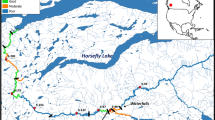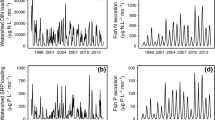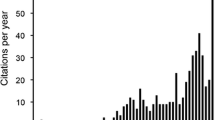Abstract
Large quantities of material are moved annually from the ocean to freshwater systems by migrating Pacific salmon. Previous studies have focused on nitrogen and phosphorus provided by spawning salmon but largely ignored micronutrients essential to aquatic productivity. We collected salmon tissue, water, and biofilm from seven southeast Alaskan streams both before and during the salmon run to test for potential micronutrient provision by salmon and uptake by biofilm. To examine temporal patterns, one stream was also sampled with high frequency. Samples were analyzed using ICP-OES for boron (B), calcium (Ca), cobalt (Co), copper (Cu), iron (Fe), potassium (K), magnesium (Mg), manganese (Mn), molybdenum (Mo), sodium (Na), selenium (Se), silicon (Si), and zinc (Zn). Arrival of salmon increased stream water loads for Ca, Fe, Mg, and Na and the concentration of Co in biofilm across the seven study streams. Stream loads of B and biofilm Cu and Na content decreased in the presence of salmon. By examining one stream at finer temporal resolution, biofilm increased in Ca, Fe, and Mn concentrations near the end of the salmon run, indicating possible lag effects between peak salmon densities and biofilm micronutrient uptake. The increase in stream water micronutrient loads across space for four elements and uptake of three elements in biofilm through time suggest that salmon are a potential source of essential micronutrients for freshwater ecosystems, as has been repeatedly demonstrated for macronutrients. This study expands our understanding of resource subsidies by identifying potential micronutrients important to those ecological dynamics.





Similar content being viewed by others
References
Adriano DC (2001) Introduction. Trace elements in terrestrial environments. Springer, Berlin, pp 1–27
Ancion PY, Lear G, Dopheide A, Lewis GD (2013) Metal concentrations in stream biofilm and sediments and their potential to explain biofilm microbial community structure. Environ Pollut 173:117–124
Anderson WB, Polis GA (1999) Nutrient fluxes from water to land: seabirds affect plant nutrient status on Gulf of California islands. Oecologia 118:324–332
Bates D, Maechler M, Bolker B, Walker S (2014) lme4: Linear mixed-effects models using Eigen and S4. R package version 1:1–23
Bigler BS, Welch DW, Helle JH (1996) A review of size trends among North Pacific salmon (Oncorhynchus spp.). Can J Fish Aquat Sci 53:455–465
Bowker MA, Belnap J, Davidson DW, Phillips SL (2005) Evidence for micronutrient limitation of biological soil crust: Importance to aird-lands restoration. Ecol Appl 15:1941–1951. https://doi.org/10.1890/04-1959
Chen X, Stewart PS (2002) Role of electrostatic interactions in cohesion of bacterial biofilms. Appl Microbiol Biotechnol 59:718–720
Collins SM, Kohler TJ, Thomas SA et al (2016) The importance of terrestrial subsidies in stream food webs varies along a stream size gradient. Oikos 125:674–685
Dabeka RW, Bradley P, Mckenzie AD (2002) Routine, high-sensitivity, cold vapor atomic absorption spectrometric determination of total mercury in foods after low-temperature digestion. J AOAC Int 85:1136–1143
Downs TM, Schallenberg M, Burns CW (2008) Responses of lake phytoplankton to micronutrient enrichment: a study in two New Zealand lakes and an analysis of published data. Aquat Sci 70:347–360
Farnham IM, Singh AK, Stetzenbach KJ, Johannesson KH (2002) Treatment of nondetects in multivariate analysis of groundwater geochemistry data. Chemom Intell Lab Syst 60:265–281
Gende SM, Edwards RT, Willson MF, Wipfli MS (2002) Pacific Salmon in Aquatic and Terrestrial Ecosystems: Pacific salmon subsidize freshwater and terrestrial ecosystems through several pathways, which generates unique management and conservation issues but also provides valuable research opportunities. Bioscience 52:917–928
Gende SM, Quinn TP, Willson MF et al (2004) Magnitude and fate of salmon-derived nutrients and energy in a coastal stream ecosystem. J Freshw Ecol 19:149–160
Goldman CR (1972) The role of minor nutrients in limiting the productivity of aquatic ecosystems
Iyengar GV (1989) Elemental analysis of biological systems: biological, medical, environmental, compositional, and methodological aspects. CRC Press, USA
Janetski DJ, Chaloner DT, Tiegs SD, Lamberti GA (2009) Pacific salmon effects on stream ecosystems: a quantitative synthesis. Oecologia 159:583–595
Kuchapski KA, Rasmussen JB (2015) Food chain transfer and exposure effects of selenium in salmonid fish communities in two watersheds in the Canadian Rocky Mountains. Can J Fish Aquat Sci 72(7):955–967
Lamberti GA, Chaloner DT, Hershey AE (2010) Linkages among aquatic ecosystems. J North Am Benthol Soc 29:245–263
Larson CA, Liu H, Passy SI (2015) Iron supply constrains producer communities in stream ecosystems. FEMS Microbiol Ecol. https://doi.org/10.1093/femsec/fiv041
Larson CA, Mirza B, Rodrigues JLM, Passy SI (2018) Iron limitation effects on nitrogen-fixing organisms with possible implications for cyanobacterial blooms. FEMS Microbiol Ecol. https://doi.org/10.1093/femsec/fiy046
Levi PS, Tank JL, Rüegg J et al (2013) Whole-stream metabolism responds to spawning Pacific salmon in their native and introduced ranges. Ecosystems 16:269–283
Levi PS, Tank JL, Tiegs SD et al (2011) Does timber harvest influence the dynamics of marine-derived nutrients in Southeast Alaska streams? Can J Fish Aquat Sci 68:1316–1329
Marcarelli AM, Baxter CV, Mineau MM, Hall RO (2011) Quantity and quality: unifying food web and ecosystem perspectives on the role of resource subsidies in freshwaters. Ecology 92:1215–1225
Marczak LB, Thompson RM, Richardson JS (2007) Meta-analysis: trophic level, habitat, and productivity shape the food web effects of resource subsidies. Ecology 88:140–148
Mathisen OA, Parker PL, Goering JJ et al (1988) Recycling of marine elements transported into freshwater systems by anadromous salmon: With 4 figures and 3 tables in the text. Internationale Vereinigung für theoretische und angewandte Limnologie: Verhandlungen 23:2249–2258
Mitchell NL, Lamberti GA (2005) Responses in dissolved nutrients and epilithon abundance to spawning salmon in southeast Alaska streams. Limnol Oceanogr 50:217–227
Moore JW, Schindler DE (2004) Nutrient export from freshwater ecosystems by anadromous sockeye salmon (Oncorhynchus nerka). Can J Fish Aquat Sci 61:1582–1589
Naiman RJ, Bilby RE, Schindler DE, Helfield JM (2002) Pacific salmon, nutrients, and the dynamics of freshwater and riparian ecosystems. Ecosystems 5:399–417
O Keefe TC, Edwards RT (2003) Evidence for hyporheic transfer and removal of marine-derived nutrients in a sockeye stream in southwest Alaska. American Fisheries Society, USA, pp 99–110
Passy SI (2010) A distinct latitudinal gradient of diatom diversity is linked to resource supply. Ecology 91:36–41. https://doi.org/10.1890/09-0545.1
Passy SI (2009) The relationship between local and regional diatom richness is mediated by the local and regional environment. Glob Ecol Biogeogr 18:383–391. https://doi.org/10.1111/j.1466-8238.2009.00453.x
Peñuelas J, Fernández-Martínez M, Ciais P et al (2019) The bioelements, the elementome, and the biogeochemical niche. Ecology. https://doi.org/10.1002/ecy.2652
Polis GA, Anderson WB, Holt RD (1997) Toward an integration of landscape and food web ecology: the dynamics of spatially subsidized food webs. Annu Rev Ecol Syst 28:289–316
Polis GA, Power ME, Huxel GR (2004) Food webs at the landscape level. University of Chicago Press, Chicago
Pringle CM, Paaby-Hansen P, Vaux PD, Goldman CR (1986) In situ nutrient assays of periphyton growth in a lowland Costa Rican stream. Hydrobiologia 134:207–213
R Core Team (2018) R: a language and environment for statistical computing. R Foundation for Statistical Computing, Vienna, Austria. https://www.R-project.org/
Reisinger AJ, Chaloner DT, Rueegg J et al (2013) Effects of spawning Pacific salmon on the isotopic composition of biota differ among southeast Alaska streams. Freshw Biol 58:938–950
RStudio Inc. (2018) RStudio: integrated development for R. RStudio, Inc, Boston, MA. https://www.rstudio.com
Rüegg J, Tiegs SD, Chaloner DT, Levi PS, Tank JL, Lamberti GA (2011) Salmon subsidies alleviate nutrient limitation of benthic biofilms in southeast Alaska streams. Can J Fish Aquat Sci 68(2):277–287
Rüegg J, Chaloner DT, Levi PS et al (2012) Environmental variability and the ecological effects of spawning Pacific salmon on stream biofilms. Freshw Biol 57:129–142
Rüegg J, Chaloner DT, Ballantyne F, Levi PS, Song C, Tank JL, Tiegs SD, Lamberti GA (2020) Understanding the relative roles of salmon spawner enrichment and disturbance: a high-frequency, multi-habitat field and modeling approach. Front Ecol Evol 8:19
Sabo JL, Power ME (2002) River–watershed exchange: effects of riverine subsidies on riparian lizards and their terrestrial prey. Ecology 83:1860–1869
Sarica J, Amyot M, Hare L, Doyon MR, Stanfield LW (2004) Salmon-derived mercury and nutrients in a Lake Ontario spawning stream. Limnol Oceanogr 49(4):891–899
Schindler DE, Leavitt PR, Brock CS et al (2005) Marine-derived nutrients, commercial fisheries, and production of salmon and lake algae in Alaska. Ecology 86:3225–3231. https://doi.org/10.1890/04-1730
Sprengel C (1828) Von den Substanzen der Ackerkrume und des Untergrundes. J fur Tecnische und Okonomische Chemie 2:423–474
Sterner RW, Elser JJ (2002) Ecological stoichiometry: the biology of elements from molecules to the biosphere. Princeton University Press, Princeton
Stewart-Oaten A, Murdoch WW, Parker KR (1986) Environmental Impact Assessment: “Pseudoreplication” in Time? Ecology 67:929–940. https://doi.org/10.2307/1939815
Tank JL, Rosi-Marshall EJ, Griffiths NA et al (2010) A review of allochthonous organic matter dynamics and metabolism in streams. J North Am Benthol Soc 29:118–146
Tank JL, Reisinger AJ, Rosi EJ (2017) Nutrient limitation and uptake. In: Methods in stream ecology. Academic Press, pp 147–171
Tiegs SD, Campbell EY, Levi PS et al (2009) Separating physical disturbance and nutrient enrichment caused by Pacific salmon in stream ecosystems. Freshw Biol 54:1864–1875
Tiegs SD, Chaloner DT, Levi P et al (2008) Timber harvest transforms ecological roles of salmon in southeast Alaska rain forest streams. Ecol Appl 18:4–11
Vanni MJ, McIntyre PB (2016) Predicting nutrient excretion of aquatic animals with metabolic ecology and ecological stoichiometry: a global synthesis. Ecology 97:3460–3471
Willson MF, Gende SM, Bisson PA (2004) Anadromous fishes as ecological links between ocean, fresh water, and land. Food webs at the landscape level University of Chicago Press, Chicago, pp 284–300
Willstätter R, Stoll A (1913) Untersuchungen über chlorophyll: methoden und ergebnisse. J. Springer, Berlin
Wurzburger N, Bellenger JP, Kraepiel AM, Hedin LO (2012) Molybdenum and phosphorus interact to constrain asymbiotic nitrogen fixation in tropical forests. PLoS ONE 7:e33710
Acknowledgements
Courtney Currier, Dominic Chaloner, and Janine Rüegg wrote the manuscript along with important contributions from all co-authors. In particular, Courtney Currier conducted all laboratory and data analyses. Janine Rüegg, Dominic Chaloner, Dave D’Amore, and Scott Tiegs oversaw or played important roles in field sampling. Gary Lamberti was the principle investigator on the grant and conceived the original study design. All authors reviewed and commented on the content of the manuscript. We thank Ann Marie Larquier, Sarah Winikoff, Angeline Kosnik, Mollie McIntosh, and Emily Campbell for assistance in the field and laboratory; Aaron Prussian, Katherine Prussian, and Steve McCurdy for insights about streams on Prince of Wales Island; Rick Edwards, Jacob Berkowitz, Erik Norberg, Mike Brueseke, and Susanne Hebbeler for logistical support. We also thank the Thorne Bay and Craig Ranger Districts (USDA Forest Service) as well as the Juneau Forestry Science Laboratory (USDA Forest Service) for their collaboration and support of this project. This research was supported by the USDA-CSREES National Research Initiative Competitive Grants Program (Managed Ecosystems Program 2006-35101-16566) and the Pacific Northwest Research Station (USDA Forest Service). Fish sampling was conducted under IACUC #06-086 from the University of Notre Dame.
Author information
Authors and Affiliations
Corresponding author
Additional information
Publisher's Note
Springer Nature remains neutral with regard to jurisdictional claims in published maps and institutional affiliations.
Electronic supplementary material
Below is the link to the electronic supplementary material.
Rights and permissions
About this article
Cite this article
Currier, C.M., Chaloner, D.T., Rüegg, J. et al. Beyond nitrogen and phosphorus subsidies: Pacific salmon (Oncorhynchus spp.) as potential vectors of micronutrients. Aquat Sci 82, 50 (2020). https://doi.org/10.1007/s00027-020-00725-z
Received:
Accepted:
Published:
DOI: https://doi.org/10.1007/s00027-020-00725-z




